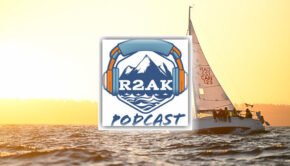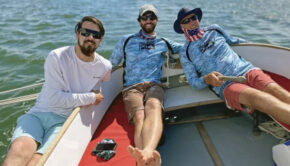R2AK: Hard Charging into the Record Books
Published on June 30th, 2016
The Race to Alaska (R2K) is a unique 750-mile marathon open to all forms of non-motorized craft. Entrants can have no support of any type; it’s like the Iditarod but on a boat. Avoid drowning, freighters, killer whales, and grizzly bears, and the winner gets $10,000. A set of steak knives awaits the runner-up.
It is a two stage event, with the first stage from Port Townsend, WA to Victoria BC as a 40 mile qualifier before entrants can start the 710 stage from Victoria BC to Ketchikan, AK on June 26. Here’s the update from the finish line…
While the R2AK nation slept sound in the knowledge that they would rise in plenty of time to check the tracker and box out a spot in the online que for the coveted feed of the Ketchikan harbor cam, Team MAD Dog Racing was hurtling through the night on a downwind screamer. 23 knots downwind through the great wide open of Dixon Entrance. Full throttle in the darkest night that the crew had ever seen. No stars, no moon, no lights from an uninhabited shoreline, just black stallion racing into the spray filled darkness.
“We couldn’t tell where the horizon started, it was too dark to know where the boat and the water were.” By the time we all woke up and checked the tracker, then checked it again, they were close. Oh my god close. All over Ketchikan you could hear forks hit plates in a mid bite mind blow that had people breaking into a dead sprint, breakfast left half eaten and steaming on the table so they could get to the finish line on time.
You know that sweaty nervous panic you get when you oversleep for a job interview? Same thing happened all over town as folks threw on clothes and danced the dance of people trying to put on pants and move at the same time. One driver clocked the M32 along the waterfront road south of town, his car barely keeping pace in an impromptu race within a race that only he knew he was losing. How are they that fast? Team MAD Dog Racing was within sight of the finish line and they were still sending it, fast. Even the press was surprised, some slipping in to the back of the crowd in the hopes that their competitors wouldn’t notice.
Their two red hulls nosed over the finish line at 7:13 am on June 30, and unless our fading memory of public school math once again miffed the complex +1 of the time zone calc, Team MAD Dog finished the R2AKin 3 days, 20 hours, and 13 minutes, smashing last year’s top finish by…well, a lot…way more than a day…you do the math.
They were greeted on the dock by a crowd still hustling down the gangway, Colin’s mom who exploded in the emotion of complete celebration and unfettered relief—hard to have a dry eye when an exhausted racer is embraced by the love and pride of his exhausted mom who had likely slept more than her dry-suited son, but not much. So proud.
They nailed the landing, rang the bell, had the rare experience of clearing customs with smiling officers who seemed to want to shake their hands as much as they wanted to look at their passports. They posed for pictures, pressed the press, double-fisted coffee and beer until adrenaline shrank to number two or three on the ranked list of their bodily fluids, before Randy received the R2AK’s version of a NASCAR shower and beer sprayed towards faces in a well-deserved celebration.
They made it. More than that, they crushed it, and landed on the dock with deeply satisfied smiles that masked their exhaustion. Triumph would win over sleep for a few more hours, but only barely.
The cameras and microphones asked the questions we all wanted to:
• Did you sleep? 20 minutes at a time, maybe every 12 hours, in a bivvy sack, in their drysuits, arms crossed to wedge themselves into position on the rack that felt most secure. Yes, it was eerily like a body bag. In one hand they’d grasp a knife in case they had to cut themselves out in the event that their dreams turned into the least exciting/most terrifying kind of wet. Tacking upwind cut the sleeping shifts short, and no matter how short the interval they’d wake, emerge from, stow the bivvy, move to the high side, and then crawl back in to catch whatever sleep they could grab before it happened again.
• How often? There are a lot of narrow passages, and with a fast boat sometimes hours would go by without 10 minutes between maneuvers.
• How did you avoid driftwood? Mostly, these sailing Jedi used the force. “When it gets dark the driftwood seems to disappear.”
• Aren’t you tired? How are you still standing? The answer to that was met with laughter and an answer to the next question. They saw whales, no bears, were blown away by their luck in the tidal gates, amazed and satisfied that the work they had done to battle harden their spindly mess of high tension speed to the rigors of a non-stop charge through the wild coast had been successful. “We raced the boat hard beforehand to identify components that needed strengthened” You mean you broke a lot of stuff in some other races? “Yeah.”
Family and friends lingered after the crowd subsided and the sunburnt and weary trio sank into the first hot meal they’d had in four days that hadn’t been rehydrated. After so much time hanging onto a bouncing net in pitching seas, they struggled to walk up the ramp, or stand still enough to focus on the menu above the counter. Dry land had become foreign to them.
After all hands sailing the cell service void of the R2AK’s back nine, they’d been out of touch with the outside world for days, and like anyone in and around the R2AK, it wasn’t long before they shifted their eyes to the tracker checking on teams and getting excited, beginning the process of piecing together the fatigue filled memories into a cogent story and then started getting excited about the progress of teams that impressed them.
They traded stories of their favorites. Their first? Team Hodge. Hodge was a garage built 8-footer that made the run in stage one. Hodge. There couldn’t have been a team in the race so opposite to the skittery rocket they’d just ridden to Ketchikan. They were accomplished sailors on a high twitch speed machine. Hodge built his own slab-sided plywood wonder out of a potentially appropriate three sheets, painted her blue, and then cut down some tarps for sails. They wore technical clothing, Hodge wore a sailor hat in a manner that was in the blurry no-mans land in the war between irony and sincerity. Still, after the race of a lifetime and a new world record, they didn’t pause between their bacon filled bites to gush full-mouthed enthusiastic about how impressed they were that he made it across stage one, or how infected they were by his spirit and enthusiasm. They have hearts as big as their skill.
They worked through the fleet: Team Jungle Kitty’s location brought excitement and memories. “That’s a tricky spot”, as did the four-way battle that was shaping up for the steak knives. “We’ve got a race!” With each bite they relaxed, their fatigue rising to the surface little by little and their excited chatter was replaced with longer and longer stares and sleepy satisfied smiles. Ian broke the silence with a question that revealed just how total had been their focus on the goal “Wait, is there an airport here?”
Team MAD Dog Racing’s charge north was impressive, and one that had many in the sailing world shaking their heads. “This will end badly.” was a word of warning from a skeptical expert in the know. The M32 was a high stakes gamble. A gust and a capsize and it would be game over. Short of a nearby tugboat there would be no way to get the big cat back on her feet. Their plan—ditch the rig, get her right side down and start pedaling. Each of them wore dry suits kitted out with life jackets, DSC marine band radio Personal Locator Beacons, and some inflatable noodles they could inflate to make it easier for rescue crews to see them. These weren’t maverick yahoos with a death wish, they took safety as seriously as they did their sailing. And while they never needed it, their ace in the hole was a mark of all pro.
As they trundled off to some much earned sleep, the rest of us shook our heads, checked our math, shook our heads again, checked the tracker, and got excited for the next wave of gritty excellence headed north like a freight train. Four teams in striking distance, two monohulls each being chased by their own Cerberus. They’ll pass soon across Dixon entrance, and all of us will be adjusting our expectations ever earlier. The race has just begun.
Event details – Facebook – Twitter – Stage 1 tracker – Stage 2 tracker
Source: Race to Alaska;, June 30, 2016
Background:
Stage 1: Port Townsend, WA to Victoria BC (40 miles)
It all begins June 23 with an initial race across open water, two sets of shipping lanes, and an international border. The first stage is designed as a qualifier for the full race and as a stand-alone 40 mile sprint for people who just want to put their toe in. Racers continuing on will clear Canadian customs in Victoria. Stage one winners get to bask in the glory for a full day and a half.
Stage 2: Victoria BC to Ketchikan, AK (710 miles)
There’s no time splits from the qualifier that roll over when the fleet starts in Victoria on June 26. The race for the prizes – real or imagined – is getting to Ketchikan. For those that lag, they risk getting tapped out by the sweep boat which heads north along the course as a rolling disqualifier. Any competitor the sweep boat passes is out of the race. Other than two waypoints at Seymour Narrows and Bella Bella, there is no official course. To quote the bard: You can go your own way.
Winner: The 2015 race was won by Team Elsie Piddock – Al Hughes, Graeme Esarey, and Matt Steverson – that crushed the fleet in a F-25c, completing Stage 2 in 5 days, 1 hour, 55 minutes. They finished almost 40 hours ahead of the second place finisher Team MOB Mentality (F85SR, a 28′ Farrier “Super Racer”) which just edged by 4 minutes third place finisher Team Por Favor (Hobie 33).







 We’ll keep your information safe.
We’ll keep your information safe.